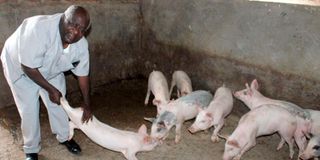I have no regrets retiring from hospitality to start rearing pigs

Peter Ludava with one of the pigs he rears. He ventured into pig rearing after retiring from the hotel industry. He now sells his products to Farmers Choice.
When 74-year-old Peter Ludava retired from his job as an executive officer in the hotel industry in the coastal region in 2001, he departed from the norm of many by venturing into a field of business he had no knowledge of.
Mr Ludava, who had just acquired a 40 acre piece of land – Mudete farm– in Trans Nzoia County, chose to follow his passion of becoming a pig farmer alongside which he launched other agricultural ventures in an integrated farming initiative.
“I formally began pig farming in 2005 where my son bought and carried six piglets from Kangemi in Nairobi which formed the first herd on this farm. They formed our foundation and learning experience on the field,” he says.
Following advice from experts from Farmers Choice, Mr Ludava put up a simple pigsty costing about Sh500,000 which contained ten 12x12ft square on a ¼ acre of land on which the pigs have been raised since then.
“We were told to start small. Compared with other livestock such as sheep, goats and cattle, pigs are sensitive animals requiring a higher level of management,” says Mr Ludava.
Hog production
He says from his research, he learnt that there is the Large White-A robust which is adaptable and of higher performance than most other breeds; the Landrace, which is a flexible breed performing well under either indoor or outdoor systems of management and the Duroc breed, whose flesh is succulent and heavy muscled making it very suitable for anything from light pork to heavy hog production.
After setting up the structure, he specialised in breeding with his key market being the sale of sows that have been served to farmers while mature male pigs (boers) are sold to Farmers Choice for meat.
He notes that pig feeding is the most expensive activity in pig rearing because it takes up to 80 per cent of the total recurrent budget to meet the market weight.
There are several types of pig feeds concentrates used in the country today: Starter feed, Grower feed, Sow and weaner feed, and pig finisher feed.
“The cost of feed is a challenge because we acquire the best quality in Uganda at a higher cost owing to taxation and transportation factors. We also blend with our local fed,” says Mr Ludava.
Pigs are fed with these feeds depending on their age while piglets require starter meal from one week to three months, and it is recommended that they are fed as much food as they want, which means they require continuous access to feed so that they grow well from the start.
The farm has adequate supply of water which is essential for growing pigs and should always be available for the animals as they grow otherwise they will not be able to feed properly hence growth rate will be affected.
The farm freely offers extension services on the best pig husbandry practices to local farmers and students from institutions of higher learning pursuing courses in the agricultural field.
The farm manager, Mr Dismas Masete, says pig waste is very high in nutrients that are used in fertilising tissue culture banana plantation which is adjacent to the pigsty.
During the first period when he ventured into the businesses, he had a challenge in getting veterinary services for the pigs since most providers are experienced in managing cows as opposed to pigs.
“We learned the hard way and after some time, my team and I mastered the art of managing pigs from teeth clipping, de-worming and treatment of various diseases, “ says Ludava.
He says he has never regretted his move to venture into pig farming since the returns are far much better than for instance dairy cows owing to the farrowing frequency and growth rate.
“The returns I get from pig farming are higher than other ventures on this farm. For instance, I only sell sheep for pocket money or meat for my family but not for economic reasons since I have pigs to care for,” he says.
Apart from pig farming the farm has 17 dairy cows, 18 sheep, seven calves, four acres of coffee, 28 acres of maize poultry and tree farming.





